Inizialmente ho evitato di usare il filo metallico perché avevo sentito tante storie dell'orrore da altre ricamatrici a macchina. Ma col tempo, la tentazione di aggiungere un bellissimo scintillio al mio disegni da ricamo mi ha ispirato a provarli. Il risultato è stato fantastico!
It wasn’;All'inizio non è facile, ma una volta ho imparato alcune nozioni di base del ricamo con filo metallico, è diventato facile aggiungere brillantezza ai miei progetti.
If you’;sei frustrato dal filo metallico, questo tutorial approfondito ti insegnerà come ricamare ogni volta con successo con il filo metallico!
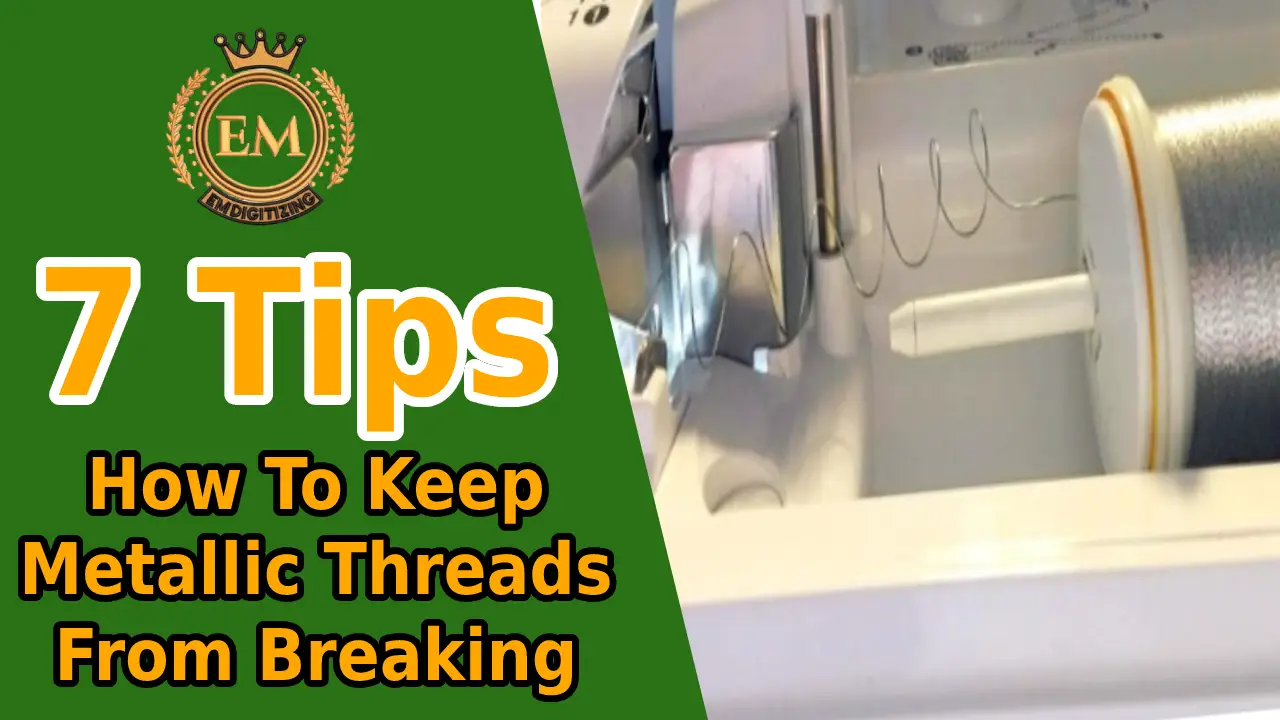
Servizi di digitalizzazione del ricamo
Come vengono realizzati i fili metallici?
Let’;Iniziamo parlando di come vengono realizzati i fili metallici in modo da poter capire perché possono causare così tanti problemi.
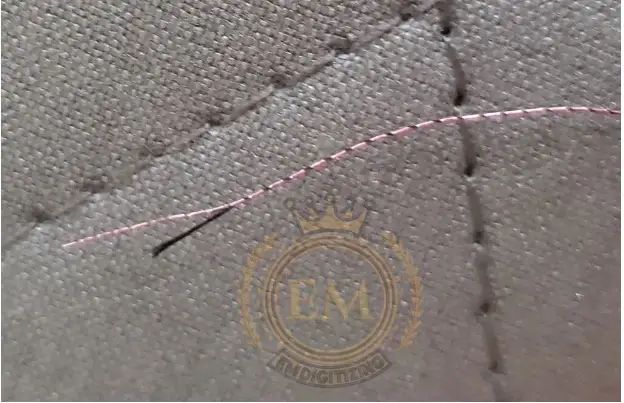
Sopra, Ne ho smontato uno per mostrarti i due strati!
Come potete vedere, i fili metallici sono realizzati con uno strato di lamina metallica avvolta attorno a un robusto nucleo interno in nylon o poliestere. It’;Non è troppo difficile separare gli strati a mano, which means your machine will happily separate the layers for you if it’;non è impostato correttamente.
Nonostante l'avvolgimento in alluminio, questi fili dovrebbero essere relativamente lisci al tatto. Tuttavia, if they don’;Non funziona facilmente con due dita, they can’;Non scorre facilmente attraverso la tua macchina!
Perché è così difficile ricamare con il filo metallico?
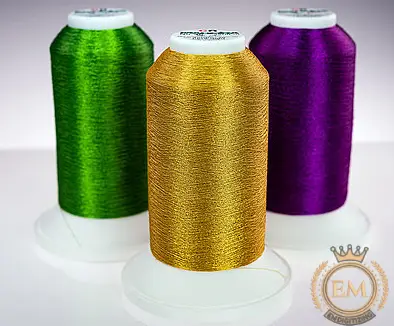 Pensa all'ago della tua macchina da cucire che si muove su e giù ad alta velocità e come può influenzare quel sottile strato di metallo avvolto.
Pensa all'ago della tua macchina da cucire che si muove su e giù ad alta velocità e come può influenzare quel sottile strato di metallo avvolto.
Se il filo sfrega troppo velocemente contro il tessuto, l'ago, o all'interno della macchina, la lamina metallica potrebbe rompersi.
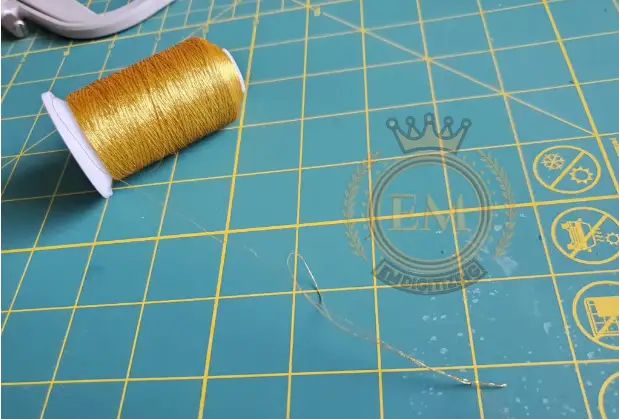
Per complicare le cose, Il filo metallico tende a girare, Kink, e bobina mentre lascia la bobina (Vedi sopra). così, Se un filo stravagante raggiunge il disco di tensione della macchina, Si blocca. Questo fa sì che il thread si rompa, rompersi e allungare davanti a questo disco di tensione.
Con il foglio separato, Questo lascia solo la parte del filo che penetra nel tessuto e il foglio di metallo si abbassa nel punto di ostruzione. Infine, La copertura interna si rompe subito dopo che la pellicola viene staccata, and you’;rimase con un grosso pasticcio.
Variazioni del filo metallico
 I thread si divertono molto, colori metallici, anche se! Ci sono i soliti colori oro e argento, ma ci sono anche dei bellissimi rosa, turchese, e persino una varietà di fili metallici.
I thread si divertono molto, colori metallici, anche se! Ci sono i soliti colori oro e argento, ma ci sono anche dei bellissimi rosa, turchese, e persino una varietà di fili metallici.
Alcune macchine sono capricciose con diverse marche di filo metallico, quindi non esiste la migliore marca di metallo filo da ricamo. I’;Attualmente utilizzo il filo metallico Thread Nanny, che mi è stato regalato, and it’;È stato fantastico. Tuttavia, ci sono molte marche da provare con la tua macchina!
Anche, il peso del filo più comune per un filo metallico è 40 peso, che è il peso standard del filo da ricamo a macchina.
Con un certo sforzo, puoi trovare il filo metallico in pesi diversi se desideri spessori di filo diversi per il tuo progetto.
Suggerimenti per il filo da ricamo metallizzato
Adesso, let’;Ora esaminiamo i parametri e vediamo la procedura di ricamo a macchina con filo metallico.
1. I migliori aghi da ricamo a macchina per filo metallico
Durante il ricamo con filo metallico, è necessario passare da uno standard 75/11 l'ago da ricamo su un nuovo ago metallico o un ago per impuntura.
Gli aghi metallici e per impuntura sono extra grandi, occhi lunghi per ridurre l'attrito ed evitare che i fili metallici si sfilaccino e si rompano. Gli aghi di metallo hanno anche un'ampia scanalatura e una larga sciarpa per proteggere il delicato filo di metallo mentre passa attraverso la cruna dell'ago. (Confuso riguardo agli aghi? Guardare: Scegli il miglior ago da ricamo per macchina in base al tuo progetto).
In termini di dimensioni, se stai ricamando su un tessuto sottile e utilizzi un filo da 40, iniziare con un 80/12 ago. Se stai ricamando su un tessuto più spesso o utilizzando 30 peso del filo, iniziare con una dimensione più grande 90/14 ago.
2. Aggiungi un supporto per filo o una configurazione di rocchetto alternativa
Per evitare l'attorcigliamento del filo metallico, Evita le configurazioni del filo orizzontale in cui il filo arriva orizzontalmente sulla parte superiore della bobina. (Vedi sotto).
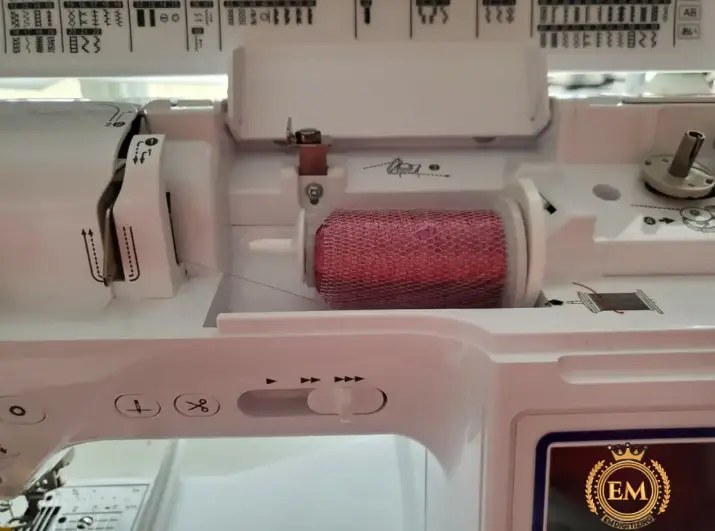
Quando si apri la ferita in orizzontale come sopra, Tornare il filo metallico più che rimuovere la ferita da una posizione verticale. Col tempo, Il filo diventa sempre più attorcigliato fino a quando non si rompe.
Se la tua macchina, Come il mio, ha solo un supporto filo orizzontale, you’;Devo trovare un modo alternativo per orientare il filo. Ho un supporto per thread Monster Embroidex (sotto) che uso per allineare i miei thread. Funziona anche alla grande per svelare fili metallici.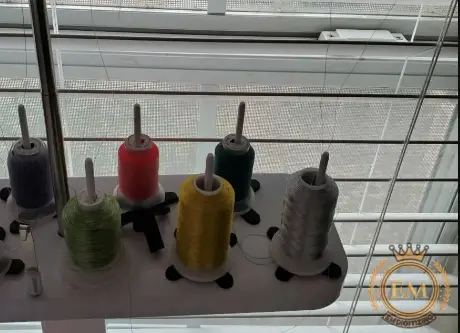
Ho anche un piccolo supporto filo che funziona abbastanza bene quando lo tengo lontano dalla mia macchina. Lo uso raramente però.
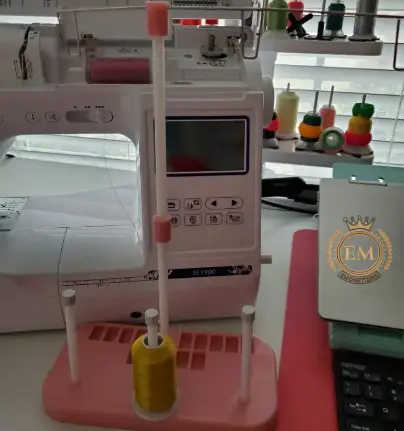
Il più lungo (Entro la ragione) Posizionhi il filo con la macchina, Più a lungo ci vorrà per rilassarsi e rilassarsi prima che il filo venga immesso nella macchina. Se riesci a spostare un piede o due di distanza, that’;è fantastico! Tuttavia, Il mio spazio per ricami è limitato, Quindi lavoro con lo spazio che ho.
Getting something like a spool holder on the bottom to attach to your machine’;L'avvolgitore della bobina migliorerà anche l'alimentazione del filo.
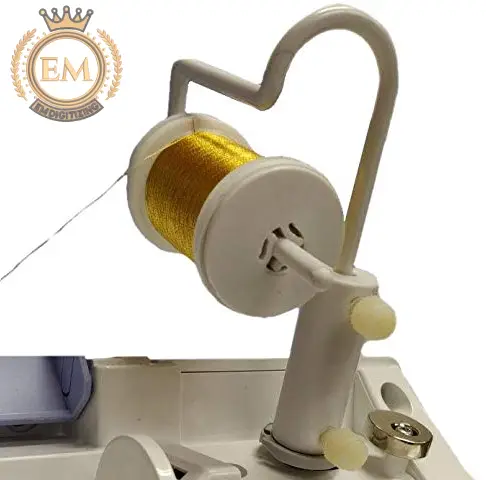
If you don’;Non voglio comprare un portafilo e voglio invece MacGyver a casa, puoi facilmente creare anche il tuo portafilo!
3. Reti di filo
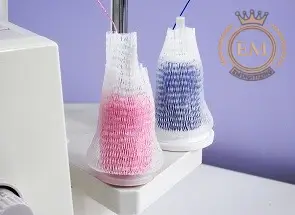
L'uso di una retina aiuta a catturare il trasporto ed evita che il filo cada sotto la bobina e si aggrovigli. Queste reti di nylon sono destinate anche a rimuovere il filo che gira prima di infilarlo nella macchina.
Di solito ho abbastanza fortuna senza rete e solo con un supporto per filo, but this is something else to try if you’;stai avendo problemi di alimentazione costanti. Assicurati solo che la maglia del filo copra l'intero cono.
4. Stabilizzatori
 Scegli il tuo stabilizzatore in base alle caratteristiche del design che stai utilizzando e al tessuto su cui stai ricamando.
Scegli il tuo stabilizzatore in base alle caratteristiche del design che stai utilizzando e al tessuto su cui stai ricamando.
Se hai opzioni, Scegli una maglia cutai o no-show invece di uno stabilizzatore di lacrima. Gli ex due tipi sono più morbidi e più flessibili, Significa che il filo è leggermente meno probabile che si strappa a causa del continuo piercing attraverso di essi.
Anche, Evita di usare l'adesivo stabilizzatori e gli spray adesivi, se possibile,. Evita tutto ciò che può tirare su questo guscio esterno.
5. Selezione del design
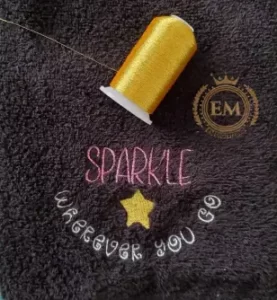 Scegli attentamente il design quando si utilizza il filo di ricamo a macchina metallica. (E, Fai sempre un punto di prova prima di iniziare a ricamare su tessuto costoso o insostituibile.)
Scegli attentamente il design quando si utilizza il filo di ricamo a macchina metallica. (E, Fai sempre un punto di prova prima di iniziare a ricamare su tessuto costoso o insostituibile.)
Per esempio, I design densi con aree di punti sovrapposti potrebbero non funzionare meglio. Cucire attraverso uno strato extra di punti oltre a tessuto e stabilizzatore rende il filo più probabile che cattura e si rompa.
Di solito mi piace ricamare la maggior parte dei miei disegni con un normale filo da ricamo e aggiungere filo metallico alla fine per un tocco finale di dettaglio.
Ci sono alcuni casi in cui potrebbe non essere ovvio che stai usando il metallo filo da ricamo. Per esempio, filo da ricamo nero metallizzato... mi sembra un semplice filo da ricamo in poliestere nero!
6. Velocità di cucitura
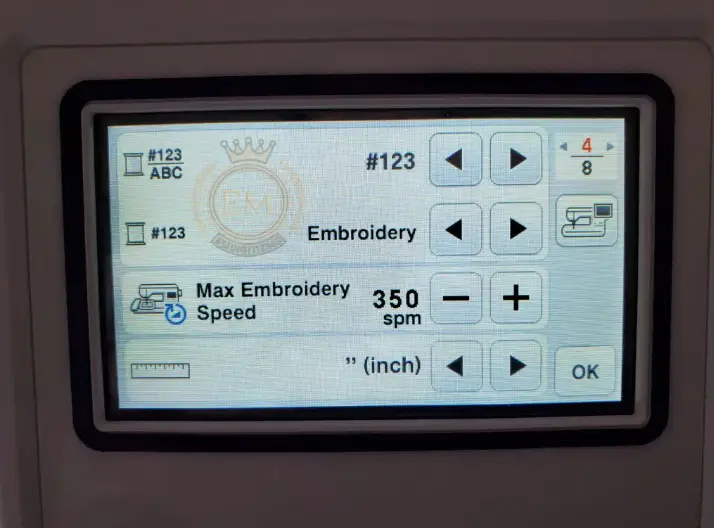
Più velocemente la tua macchina cuce, più è probabile che tu abbia problemi con la rottura o la rottura del filo.
Se hai una macchina molto veloce, Ti consiglio di tagliare i punti il più in basso possibile quando inizi a risolvere il problema per la prima volta. La mia macchina funzionerà a 350 sms, che è quello che uso con i metalli.
Anche se il punto lento implica che il disegno richieda più tempo per essere cucito, it’;È molto meglio che reinfilarli ogni pochi minuti quando i fili si rompono!
Rallentare la velocità di cucito non solo riduce i problemi, ma consente anche di recuperare eventuali errori più rapidamente e risolverli prima che causino problemi con il tuo disegno.
7. Tensione del filo
Come metallico filo da ricamo è isolato dalla bobina, Raggiunge rapidamente il disco di tensione del macchina da ricamo. Allentare la tensione della macchina riduce l'attrito su questi dischi, prevenire il tiro del filo, eseguire il backup e l'eventuale rottura mentre passa attraverso.
Come tale, Ricambio con filo metallico è una delle poche volte in cui potrebbe essere necessario abbassare la tensione della macchina per ottenere i migliori risultati.
Questa regolazione sarà specifica per la macchina, tessuto-specifico, e persino specifico per thread-brand, so there is no “;best”; tensione per thread metallici. Your user manual will have instructions on how to adjust your machine’;Stensione dalla tensione predefinita.
Apportare piccole modifiche inizialmente piuttosto che grandi cambiamenti. Senza cucire, È possibile testare come le modifiche alla tensione influiscono sul feed del filo cercando di attirare il thread attraverso la macchina a mano per ogni modifica che si apportate.
Conclusione
Ora che sai cosa va storto quando usi il metallo e i metodi circostanti e come puoi risolverli, Dovresti provare a usare di nuovo il filo metallico, Questa volta senza mal di testa!
Fammi sapere se hai trovato questo articolo utile o se hai domande di seguito.
Il motivo principale per cui i thread metallici continuano a rompersi è che è un tipo di filo sintetico. Questo lo rende particolarmente rigido rispetto a Rayon, che è straordinariamente morbido al tatto. Il poliestere è anche un filo sintetico, Ma non è difficile come metallico.
Il filo fray mentre passa ripetutamente attraverso il tessuto. Per eliminare questo problema, Taglia un pezzo di filo interdentale il doppio della lunghezza che si desidera cucire e separare un singolo filo. Piega il filo a metà, e infilare l'estremità del ciclo attraverso l'occhio dell'ago.
sì, puoi stirare i fili metallici della manovella, Ma usa un panno per press. Non posizionare il ferro caldo direttamente sul metallo, Poiché il filo si scioglierà o si restringerà. La maggior parte dei fili metallici sono sintetici, realizzato in poliestere e/o nylon, and they don’;T mi piace l'alto calore.
You shouldn’;T ha un problema a lavare i fili metallici. If you’;Non sono sicuro, Testa un pezzo di filo prima di bagnare l'intero progetto. Una punta che alcuni cuciture giurano è di refrigerare il filo metallico prima di usarlo, che dicono rende molto più facile lavorare.
Vediamo fili metallici usati nei serger per punti decorativi, Quilting a macchina, Play di discussione, e persino bordi decorativi. If you’;ve never tried using metallic thread with a needle or if you’;ve ha avuto tentativi falliti, Ecco alcune cose da sapere per iniettare quel luccichio nel tuo cucito.
